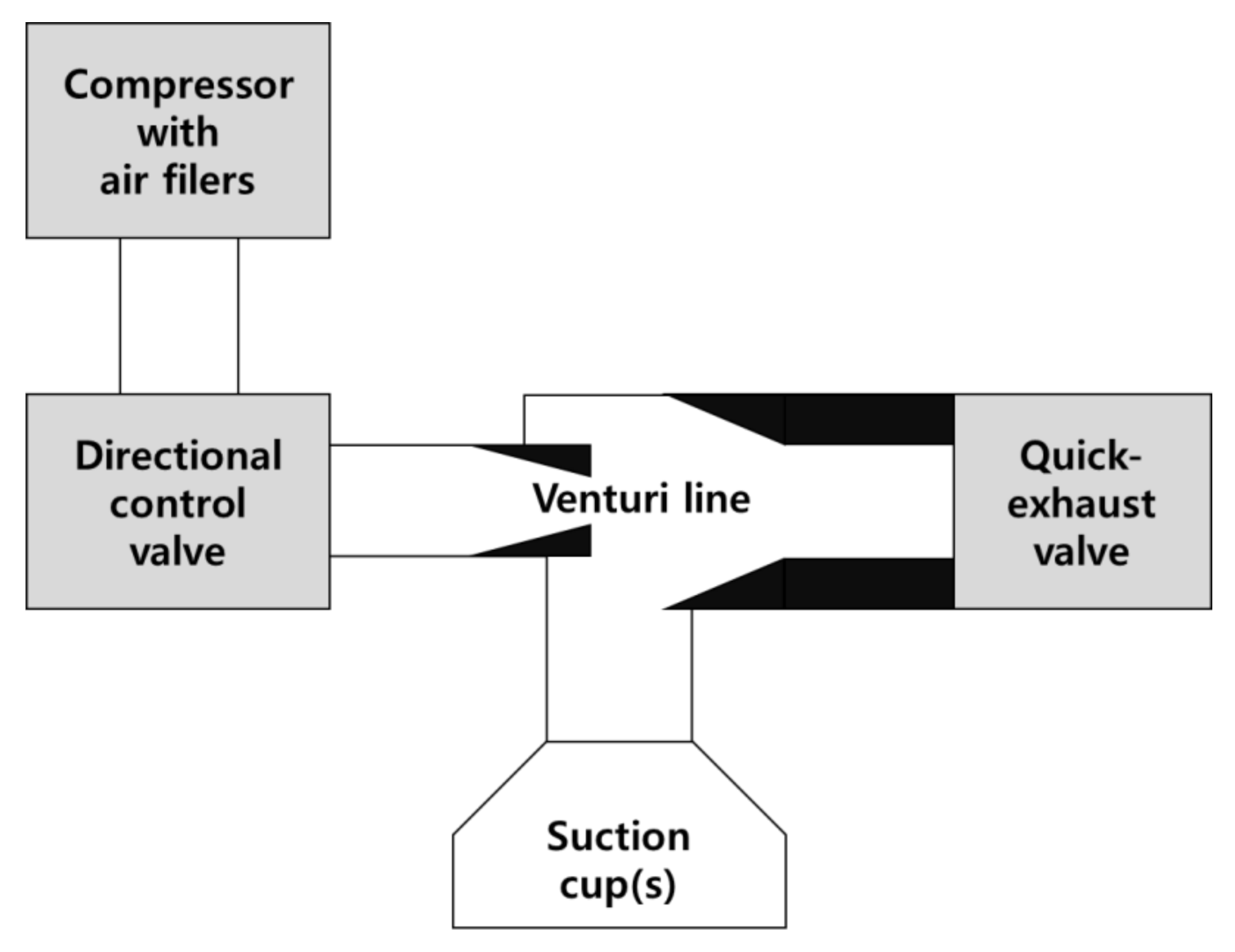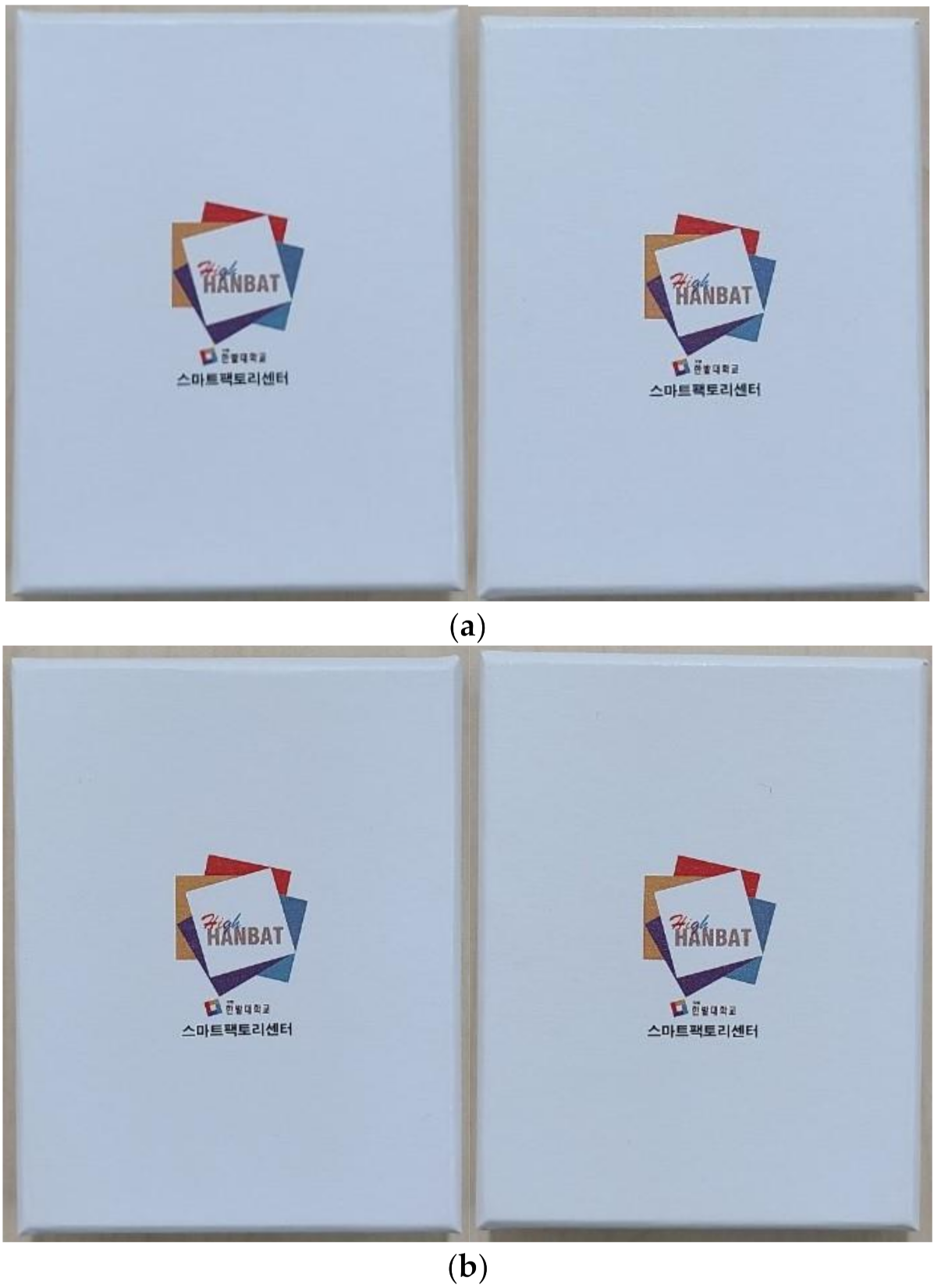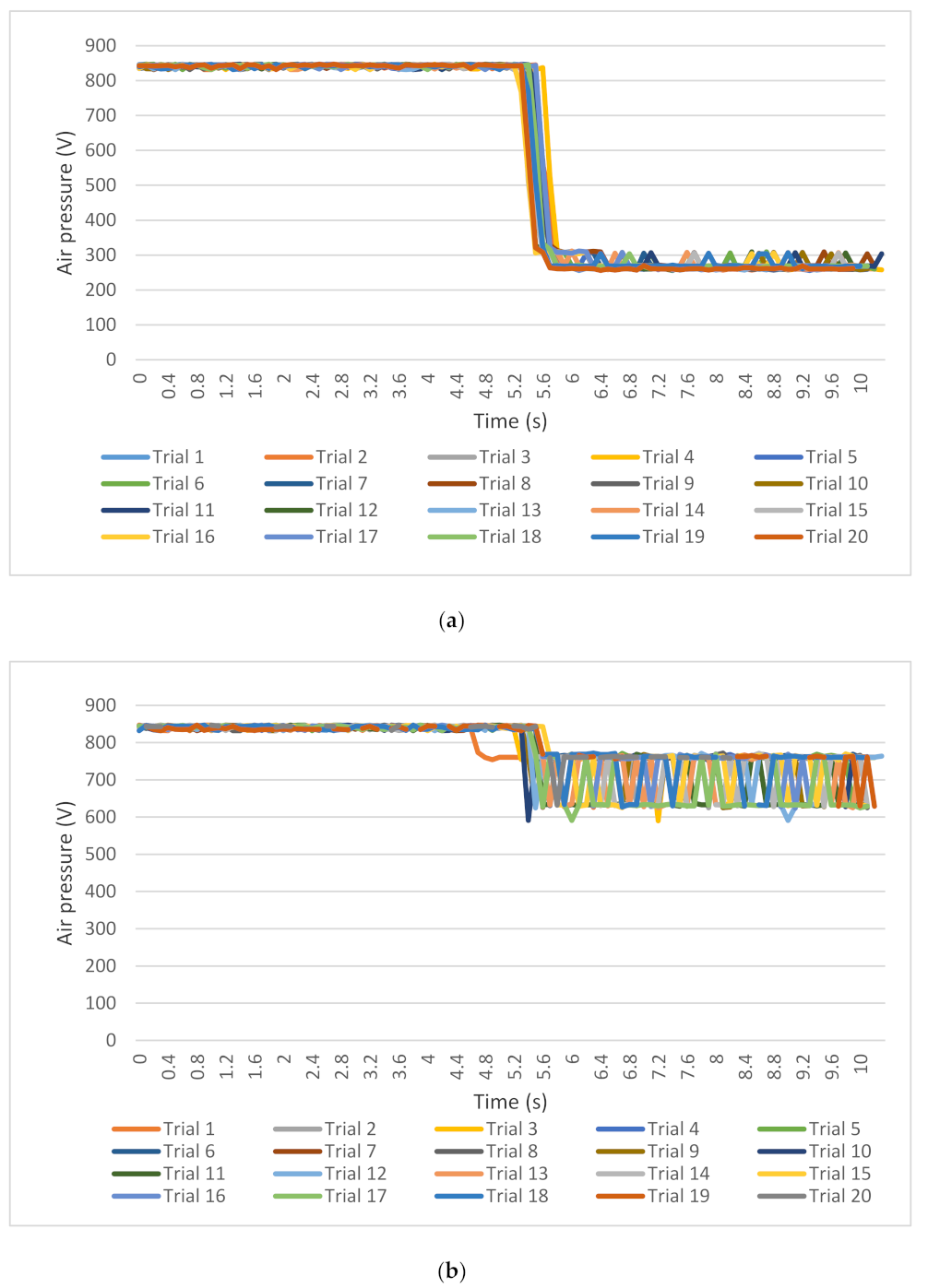Predictive Process Adjustment by Detecting System Status of Vacuum Gripper in Real Time during Pick-Up Operations
Abstract
:1. Introduction
1.1. Theoretical Background
1.2. Literature Review on Fault Detection Methods
2. Materials and Methods
2.1. Materials: System Configuration for Monitoring Pick-Up Operations in Real Time
- Make sure every module is turned on and connected to the PC-based controller via Ethernet communication.
- Send a pick-up operation message to move the robot arm and start the suction operation.
- When the suction is started by the PC-based controller, analog sensor signals (outlet air pressure) are simultaneously acquired in real time and can be monitored through the developed control software.
- After performing the given pick-up operation (regardless of the operation success), the acquired sensor signals are exported as a spreadsheet per operation.
2.2. Methods
3. Experimental Results
3.1. Result: Early Fault Detection for Pick-Up Operation
- Box type I: Normal box with a surface that is sufficiently flat to be picked up with conventional vacuum grippers and judged to be acceptable based on product quality inspection.
- Box type II: Box that appears normal in the product quality inspection but is not flat enough to be picked up using a conventional vacuum gripper (“box type II” hereinafter) owing to a slight concave curvature in its contact surface, resulting in a faulty pick-up operation.
- Start the suction operation and measure the amount of outlet air pressure in real time.
- Check the decrease during approximately short time period (i.e., 5.6 to 6.0 s), which corresponds to suction start.
- 3.1.
- If there is a sufficient decrease in air pressure, then conduct the next step (usually, move the gripper to the next position).
- 3.2.
- If the air pressure does not decrease to the desired level, then conduct the predictive process adjustment until the object is lifted by the gripper.
3.2. Discussion: Conducting Appropriate Recovery Actions
- Start the suction operation and measure the amount of outlet air pressure in real time.
- Check the decrease during approximately a short time period (i.e., 5.6 to 6.0 s), which corresponds to suction start.
- 3.1.
- If the air pressure decreases sufficiently, then perform the next step (usually, move the gripper to the next position).
- 3.2.
- If a suction step is considered a failure (i.e., air pressure does not decrease to the predefined UCL), move the z-axis downward until the air pressure falls to the UCL.
4. Conclusions
Author Contributions
Funding
Data Availability Statement
Acknowledgments
Conflicts of Interest
References
- Bai, S.; Cheng, Z.; Guo, B. Maintenance optimization model with sequential inspection based on real-time reliability evaluation for long-term storage systems. Processes 2019, 7, 481. [Google Scholar] [CrossRef] [Green Version]
- Rahman, M.; Zaccaria, V.; Zhao, X.; Kyprianidis, K. Diagnostics-oriented modelling of micro gas turbines for fleet monitoring and maintenance optimization. Processes 2018, 6, 216. [Google Scholar] [CrossRef] [Green Version]
- Lin, M.; Ruigang, T.; Yan, R.; Lei, Z.; Xizhen, S. Research on identification and measurement methods of influencing factors of investment in operation and maintenance. In E3S Web Conference 236, 3rd International Conference on Energy Resources and Sustainable Development (ICERSD 2020); 2021; p. 04010. Available online: https://www.e3s-conferences.org/articles/e3sconf/abs/2021/12/e3sconf_icersd2020_04010/e3sconf_icersd2020_04010.html (accessed on 9 February 2021).
- Furumoto, K.; Kolehmainen, A.; Silverajan, B.; Takahashi, T.; Inoue, D.; Nakao, K. Toward automated smart ships: Designing effective cyber risk management. In Proceedings of the 2020 International Conferences on Internet of Things and IEEE Green Computing and Communications and IEEE Cyber, Physical and Social Computing and IEEE Smart Data and IEEE Congress on Cybermatics, Rhodes, Greece, 2–6 November 2020; pp. 100–105. [Google Scholar] [CrossRef]
- Espadinha-Cruz, P.; Godina, R.; Rodrigues, E.M.G. A review of data mining applications in semiconductor manufacturing. Processes 2021, 9, 305. [Google Scholar] [CrossRef]
- Kim, D.-Y.; Park, J.W.; Baek, S.; Park, K.-B.; Kim, H.-R.; Park, J.-I.; Kim, H.-S.; Kim, B.-B.; Oh, H.-Y.; Namgung, K.; et al. A modular factory testbed for the rapid reconfiguration of manufacturing systems. J. Intell. Manuf. 2020, 31, 661–680. [Google Scholar] [CrossRef]
- Townsend, W. The BarrettHand Grasper—Programmably flexible part handling and assembly. Ind. Robot Int. J. 2000, 27, 181–188. [Google Scholar] [CrossRef] [Green Version]
- Li, C.; Gu, X.; Ren, H. A cable-driven flexible robotic grasper with Lego-like modular and reconfigurable joints. IEEE/ASME Trans. Mechatron 2017, 22, 2757–2767. [Google Scholar] [CrossRef]
- Shao, G.; Ware, H.O.T.; Huang, J.; Hai, R.; Li, L.; Sun, C. 3D printed magnetically-actuating micro-gripper operates in air and water. Addit. Manuf. 2021, 38, 101834. [Google Scholar]
- Amend, R.; Brown, E.; Rodenberg, N.; Jaeger, H.M.; Lipson, H. A positive pressure universal gripper based on the jamming of granular material. IEEE. Trans. Rob. 2012, 28, 341–350. [Google Scholar] [CrossRef]
- Vedhagiri, P.J.G.; Prituja, A.V.; Li, C.; Zhu, G.; Thakor, N.V.; Ren, H. Pinch grasp and suction for delicate object manipulations using modular anthropomorphic robotic gripper with soft layer enhancements. Robotics 2019, 8, 67. [Google Scholar] [CrossRef] [Green Version]
- Chen, T.; Wang, Y.; Yang, Z.; Liu, H.; Liu, J.; Sun, L. A PZT actuated triple-finger gripper for multi-target micromanipulation. Micromach 2017, 8, 33. [Google Scholar] [CrossRef] [Green Version]
- Matsuo, I.; Shimizu, T.; Nakai, Y.; Kakimoto, M.; Sawasaki, Y.; Mori, Y.; Sugano, T.; Ikemoto, S.; Miyamoto, T. Q-bot: Heavy object carriage robot for in-house logistics based on universal vacuum gripper. Adv. Robot. 2020, 34, 173–188. [Google Scholar] [CrossRef]
- Jamaludin, A.S.; Razali, M.N.M.; Jasman, N.; Ghafar, A.N.A.; Hadi, M.A. Design of spline surface vacuum gripper for pick and place robotic arms. J. Mod. Manuf. Syst. Technol. 2020, 4, 48–55. [Google Scholar] [CrossRef]
- Ashwini, K.; Rudraswamy, S.B. Automated inspection system for automobile bearing seals. Mater. Today Proc. 2020. [Google Scholar] [CrossRef]
- Seo, J.W.; Lee, J.K.; Lee, S.; Lee, K.C. Slip detection of robot gripper with flexible tactile sensor. J. Korean Soc. Precis. Eng. 2014, 31, 157–164. [Google Scholar] [CrossRef]
- Lee, J.K.; Kim, H.J.; Lee, S.; Lee, K.C. Design of grasping objects system of robot gripper using artificial neural network. In Proceedings of the 2014 KSMPE Conference, Changwon, Korea, 6–8 November 2014; p. 109. [Google Scholar]
- Jaiswal, A.K.; Kumar, B. Vacuum gripper—An important material handling tool. Int. J. Sci. Technol. 2017, 7, 1–8. [Google Scholar]
- Zhang, P.; Kamezaki, M.; Otsuki, K.; He, Z.; Sakamoto, H.; Sugano, S. Development of a vacuum suction cup by applying magnetorheological elastomers for objects with flat surfaces. In Proceedings of the 2020 IEEE/ASME International Conference on Advanced Intelligent Mechatronics (AIM), Boston, MA, USA, 6–9 July 2020; pp. 777–782. [Google Scholar]
- Nakamoto, H.; Ohtake, M.; Komoda, K.; Sugahara, A.; Ogawa, A. A gripper for robustly picking various objects placed densely by suction and pinching. In Proceedings of the 2018 IEEE/RSJ International Conference on Intelligent Robots and Systems (IROS), Madrid, Spain, 1–5 October 2018; pp. 6093–6098. [Google Scholar]
- Wang, J.; Liang, Y.; Zheng, Y.; Gao, R.X.; Zhang, F. An integrated fault diagnosis and prognosis approach for predictive maintenance of wind turbine bearing with limited samples. Renew. Energy 2020, 145, 642–650. [Google Scholar] [CrossRef]
- Jaiswal, A.K.; Kumar, B. Design constraints of vacuum cup gripper of robots-as a pick and place operation tool. Int. J. Sci. Technol. 2016, 6, 26–35. [Google Scholar]
- Jaiswal, A.K.; Kumar, B. Vacuum cup grippers for material handling in industry. Int. J. Innov. Sci. Eng. Technol. 2017, 4, 187–194. [Google Scholar]
- Papadakis, E.; Raptopoulous, R.; Koskinopoulou, K.; Maniadakis, M. On the use of vacuum technology for applied robotic systems. In Proceedings of the 2020 6th International Conference on Mechatronics and Robotics Engineering, Barcelona, Spain, 12–15 February 2020; pp. 73–77. [Google Scholar]
- Valencia, A.J.; Idrovo, R.M.; Sappa, A.D.; Guingla, D.P.; Ochoa, D. A 3D vision based approach for optimal grasp of vacuum grippers. In Proceedings of the 2017 IEEE International Workshop of Electronics, Control, Measurement, Signals and their Application to Mechatronics, Donostia-San Sebastian, Spain, 24–26 May 2017; pp. 1–6. [Google Scholar]
- Baek, S.; Kim, D.-O. Effects of Z-axis suction position of vacuum gripper to box pick-up operation. In Proceedings of the 26th Winter Conference of Society for Computational Design and Engineering, Jeju, Korea, 25–27 November 2020; p. 435. [Google Scholar]
- Baek, S.; Kim, D.-O.; Lee, S.-J.; Yu, N.-H.; Chea, S.-I. Development of air pressure measurement system of suction cups in a vacuum gripper. In Proceedings of the 21th ACIS International Semi-Virtual Winter Conference on Software Engineering, Artificial Intelligence, Networking and Parallel/Distributed Computing, Ho Chi Minh City, Vietnam, 28–30 January 2021; pp. 1–5. [Google Scholar]
- Baek, S.; Jeon, S.H.; Song, E.C. Real-time monitoring of a vacuum gripper pick-up operation in a box packaging process by CNN based the box surface deviation image analysis. J. Korean Inst. Ind. Eng. 2020, 46, 107–113. [Google Scholar] [CrossRef]
- Saufi, S.R.; Ahmad, Z.A.B.; Leong, M.S.; Lim, M.H. Challenges and opportunities of deep learning models for machinery fault detection and diagnosis: A review. IEEE Access 2019, 7, 122644–122662. [Google Scholar] [CrossRef]
- Pillai, D.S.; Blaabjerg, F.; Rajasekar, N. A comparative evaluation of advanced fault detection approaches for PV systems. IEEE J. Photovolt. 2019, 9, 513–527. [Google Scholar] [CrossRef]
- Baek, S. System integration for predictive process adjustment and cloud computing-based real-time condition monitoring of vibration sensor signals in automated storage and retrieval systems. Int. J. Adv. Manuf. Technol. 2021, 113, 955–966. [Google Scholar] [CrossRef]
- Dai, X.; Gao, Z. From model, signal to knowledge: A data-driven perspective of fault detection and diagnosis. IEEE Trans. Ind. Inf. 2013, 9, 2226–2238. [Google Scholar] [CrossRef] [Green Version]
- Bersimis, S.; Psarakis, S.; Panaretos, J. Multivariate statistical process control charts: An overview. Qual. Reliab. Eng. Int. 2007, 23, 517–543. [Google Scholar] [CrossRef] [Green Version]
- Kazemi, P.; Giralt, J.; Bengoa, C.; Masoumian, A.; Steyer, J.-P. Fault detection and diagnosis in water resource recovery facilities using incremental PCA. Water Sci. Technol. 2020, 82, 2711–2724. [Google Scholar] [CrossRef]
- Bencheikh, F.; Harkat, M.F.; Kouadri, A.; Bensmail, A. New reduced kernel PCA for fault detection and diagnosis in cement rotary kiln. Chemom. Intell. Lab. Syst. 2020, 204, 104091. [Google Scholar] [CrossRef]
- Kim, J.-M.; Wang, N.; Liu, Y.; Park, K. Residual control chart for binary response with multicollinearity covariates by neural network model. Symmetry 2020, 12, 381. [Google Scholar] [CrossRef] [Green Version]
- Verron, S.; Tiplica, T.; Kobi, A. Fault detection in a multivariate process with a Bayesian network. Qual. Assur. 2007, 51, 1–9. [Google Scholar] [CrossRef] [Green Version]
- Namgung, K.; Yoon, H.; Baek, S.; Kim, D.Y. Estimating system state through similarity analysis of signal patterns. Sensors 2020, 20, 6839. [Google Scholar] [CrossRef] [PubMed]
- Luo, W.; Hu, T.; Ye, Y.; Zhang, C.; Wei, Y. A hybrid predictive maintenance approach for CNC machine tool driven by Digital Twin. Rob. Comput. Integr. Manuf. 2020, 65, 101974. [Google Scholar] [CrossRef]
- Dini, G.; Gantoni, G.; Failli, F. Grasping leather plies by Bernoulli grippers. CIRP Ann. 2009, 58, 21–24. [Google Scholar] [CrossRef]
- Isermann, R. Fault-Diagnosis Systems; Springer: Berlin, Germany, 2006. [Google Scholar]
- Montgomery, D.C. Design and Analysis of Experiments, 10th ed.; Wiley: Hoboken, NJ, USA, 2019. [Google Scholar]
- Kuntoğlu, M.; Sağlam, H. Investigation of progressive tool wear for determining of optimized machining parameters in turning. Measurement 2019, 140, 427–436. [Google Scholar] [CrossRef]
- Shinozaki, H.; Nakao, Y. Equipment comparison analysis using ANOVA of FDC statistics. In Proceedings of the 2018 International Symposium on Semiconductor Manufacturing (ISSM), Tokyo, Japan, 10–11 December 2018; pp. 1–2. [Google Scholar]
- Naik, A.B.; Reddy, A.C. Optimization of tensile strength in TIG welding using the Taguchi method and analysis of variance (ANOVA). Therm. Sci. Eng. Prog. 2018, 8, 327–339. [Google Scholar] [CrossRef]









| Statistical Chart | Data Mining | |
|---|---|---|
| Usage of fault state data | Unsupervised learning | Supervised learning |
| Mathematical model | Yes | No |
| Gradient relationship between measurements and system operation states | Yes | Not necessary |
| Popular decision criteria | Distance from the normal states | Similarity to the known signal behaviors during fault states |
| Unit | Function |
|---|---|
| Air compressor | Supply compressed air |
| Air pressure sensor | Measure air pressure during operation |
| Air pressure gauge | Measure an initially applied amount of air pressure |
| Vacuum switch | Detect success/failure of suction |
| Four-axis robot arm | Move vacuum gripper |
| Vacuum gripper with a suction cup and single solenoid directional control valve (DCV) | Conduct suction operation |
| Arduino-based controller | Collect signals and send them to the PC |
| PC-based controller | Control the robot arm and Arduino-based controller |
| Box Types | Operation Success Rate |
|---|---|
| Box type I | 100% |
| Box type II | 0% |
| Dependent variable | Amount of outlet air pressure at approximately 5.6 to 6.0 s |
| Independent variable | Z-position with four levels (0.0, −1.0, −1.5, and −0.0 mm) |
| Number of repetitions | 10 times for each condition |
| Source | SS | df | MS | F | p-Value |
|---|---|---|---|---|---|
| Between groups | 1,777,360 | 1 | 1,777,360 | 1284 | <0.000 |
| Within groups | 52,616 | 38 | 1385 | ||
| Total | 1,829,976 | 39 |
| Z-Position | Operation Success Rate |
|---|---|
| 0.0 mm | 0% |
| −1.0 mm | 10% |
| −1.5 mm | 70% |
| −2.0 mm | 100% |
Publisher’s Note: MDPI stays neutral with regard to jurisdictional claims in published maps and institutional affiliations. |
© 2021 by the authors. Licensee MDPI, Basel, Switzerland. This article is an open access article distributed under the terms and conditions of the Creative Commons Attribution (CC BY) license (https://creativecommons.org/licenses/by/4.0/).
Share and Cite
Baek, S.; Kim, D.O. Predictive Process Adjustment by Detecting System Status of Vacuum Gripper in Real Time during Pick-Up Operations. Processes 2021, 9, 634. https://doi.org/10.3390/pr9040634
Baek S, Kim DO. Predictive Process Adjustment by Detecting System Status of Vacuum Gripper in Real Time during Pick-Up Operations. Processes. 2021; 9(4):634. https://doi.org/10.3390/pr9040634
Chicago/Turabian StyleBaek, Sujeong, and Dong Oh Kim. 2021. "Predictive Process Adjustment by Detecting System Status of Vacuum Gripper in Real Time during Pick-Up Operations" Processes 9, no. 4: 634. https://doi.org/10.3390/pr9040634
APA StyleBaek, S., & Kim, D. O. (2021). Predictive Process Adjustment by Detecting System Status of Vacuum Gripper in Real Time during Pick-Up Operations. Processes, 9(4), 634. https://doi.org/10.3390/pr9040634





